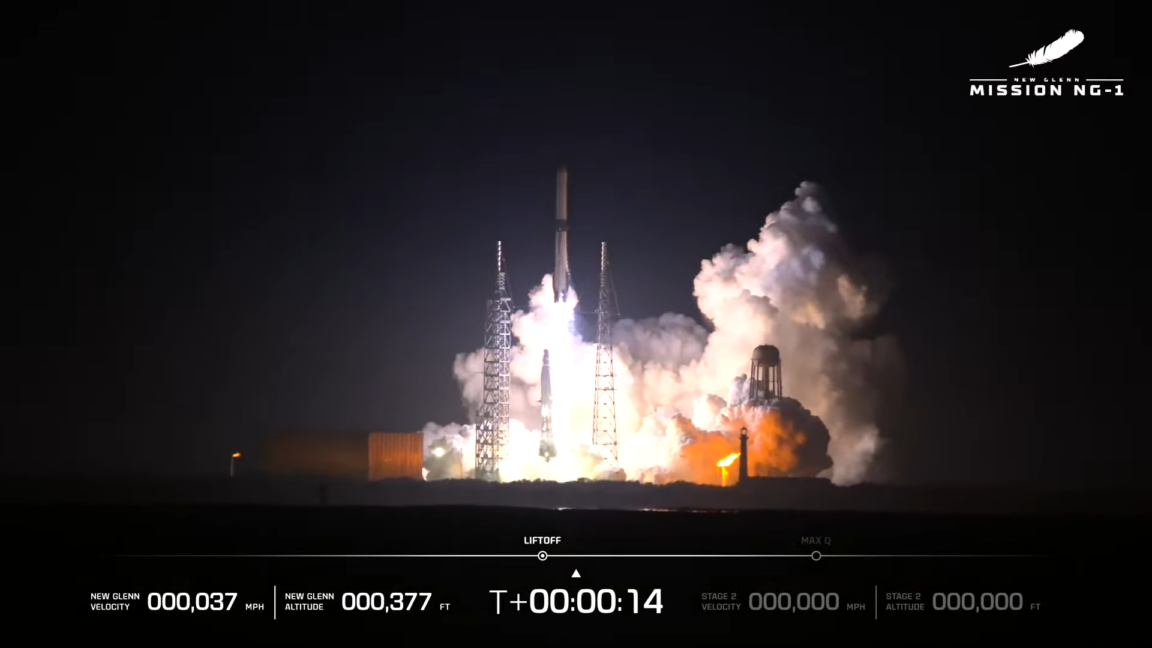Blue Origin reaches orbit on first flight of its titanic New Glenn rocket
Welcome to the club Blue Origin reaches orbit on first flight of its titanic New Glenn rocket Bypassing engine chill issues and a wayward boat, Blue Origin got to T-0. Eric Berger Jan 16, 2025 2:51 am | 11 After 14 seconds, New Glenn was still working on clearing the launch tower. Credit: Blue Origin After 14 seconds, New Glenn was still working on clearing the launch tower. Credit: Blue Origin Story textSizeSmallStandardLargeWidth *StandardWideLinksStandardOrange* Subscribers only Learn moreEarly on Thursday morning, a Saturn V-sized rocket ignited its seven main engines, a prelude to lifting off from Earth.But then, the New Glenn rocket didn't move.And still, the engines produced their blue flame, furiously burning away methane.The thrust-to-weight of the rocket must have been in the vicinity of 1.0 to 1.2, so the booster had to burn a little liquid methane and oxygen before it could begin to climb appreciably. But finally, seconds into the mission, New Glenn did begin to climb. It was slow, ever so slow. But it flew true.Flying safeAfter that the vehicle performed like a champion. The first stage burned for more than three minutes before the second stage separated at an altitude of 70 km. Then, the upper stage's two BE-3U engines appeared to perform flawlessly, pushing the Blue Ring pathfinder payload toward orbit. These engines burned very nearly for 10 minutes before shutting down, having reached an orbital velocity of 28,800 kph.For the first time since its founding, nearly a quarter of a century ago, Blue Origin had reached orbit. The long-awaited debut launch of the New Glenn rocket, a super-heavy lift vehicle developed largely with private funding, had come. And it was a smashing success.The only downer came a little bit later when Blue Origin's Ariane Cornell confirmed that the first stage did not successfully return to Earth. "We did in fact lose the booster," Cornell said during the company's webcast. Far below in the Atlantic Ocean the drone ship Jacklyn awaited, a lone and lonely sentinel, with no rocket to catch.But no one who really understands the difficulties of launching and landing rockets believed that Blue Origin would succeed in catching its first orbital booster. SpaceX required 19 launches before it finally landed an orbital rocket for the first time, back in December 2015. Blue Origin deserves credit for making the attempt, rather than criticism for failing to stick the landing.Two causes of delayThe launch occurred a little more than one hour into Thursday morning's launch window. Liftoff was delayed, at first, by an unspecified issue with properly chilling the BE-4 engines ahead of launch. They were much warmer than observed during the previous launch attempt on Monday morning.Then, as Blue Origin got deeper into the countdown, a wayward boat strayed into the keep-out zone around the launch site. These areas are cleared during launches to protect anyone below in case of a failure.But finally, the boat was cleared, and so was New Glenn, for its date with destiny. The time was 2:03 am ET (07:03 UTC). And although it was early in the day, it already was a great day for Blue Origin and its founder, Jeff Bezos, who has poured billions into the company and this rocket. Maybe the greatest one to date.Eric BergerSenior Space EditorEric BergerSenior Space Editor Eric Berger is the senior space editor at Ars Technica, covering everything from astronomy to private space to NASA policy, and author of two books: Liftoff, about the rise of SpaceX; and Reentry, on the development of the Falcon 9 rocket and Dragon. A certified meteorologist, Eric lives in Houston. 11 Comments


